Ferns of the Adirondacks:
New York Fern (Thelypteris noveboracensis)
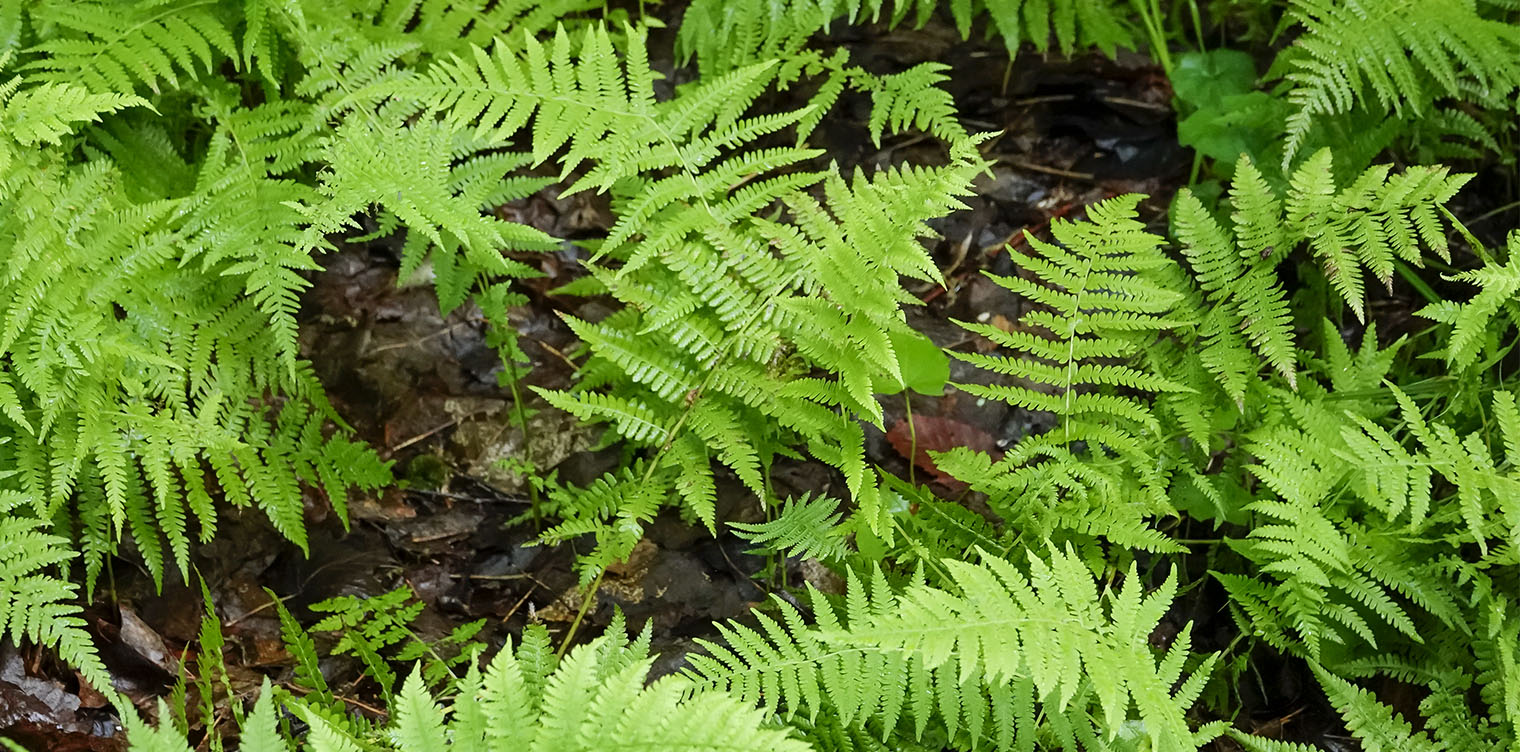
New York Ferns (Thelypteris noveboracensis) are deciduous woodland ferns that grow abundantly in both wetland and nonwetland habitats in the Adirondack Mountains of upstate New York.
The New York Fern's taxonomic status is unclear. It is one of the many species that have gone through multiple changes in classification and scientific name.
- At one time, this fern was included in the genus Dryopteris.
- In more current revisions, some sources assign the New York Fern to the family Thelypteridaceae (Marsh Fern Family) and place it in the Thelypteris genus (Marsh Ferns); in this classification the genus is a small one with about two species.
- Another approach is to treat the genus Thelypteris as the only one in the subfamily Thelypteridoideae, which (according to this scheme) would include around a thousand species.
One reflection of this lack of consensus is that different sources assign different scientific names to the New York Fern.
- Both iNaturalist and Go Botany adopt an approach assigning the New York Fern to the subfamily Thelypteridoideae and the Genus Parathelypteris, so the scientific name becomes Parathelypteris noveboracensis.
- The New York Flora Association, by contrast, currently uses the scientific name Thelypteris noveboracensis, as does the Integrated Taxonomic Information System and the US Department of Agriculture. The approach adopted here follows that of the New York Flora Association.
By contrast, this fern's nonscientific name has been quite stable over the decades. Although a few sources mention Tapering Fern as a secondary name, most stick with "New York Fern." This is an allusion to the fern's species name "noveboracensis," which is derived from the Latin Eboracum – the Roman name for the city of York in England.
Identification of New York Ferns
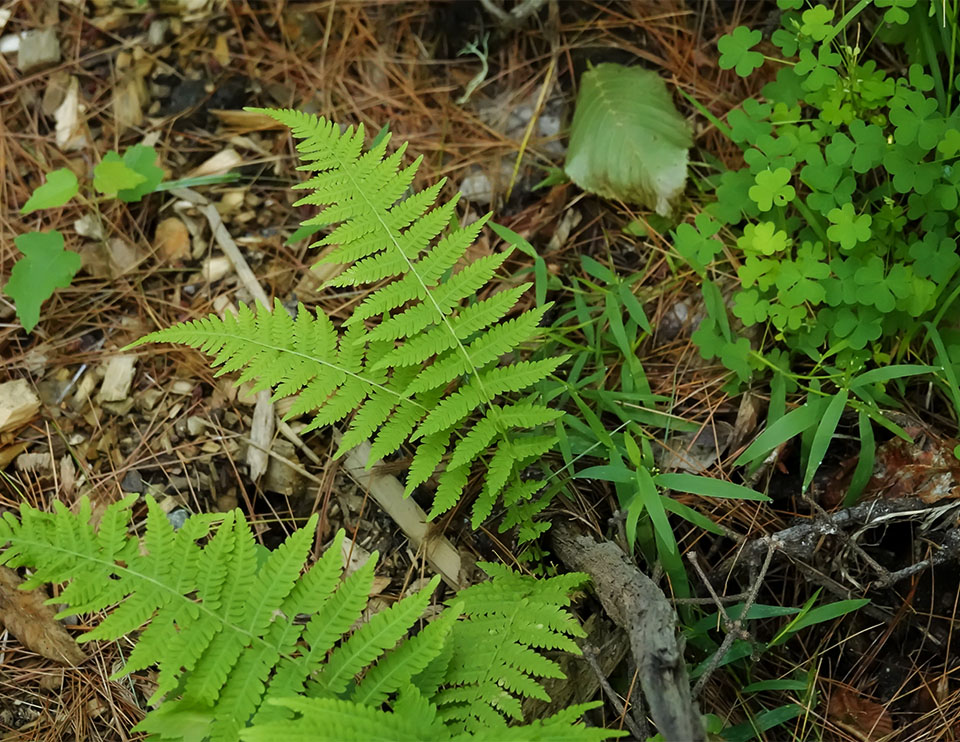
New York Ferns are medium-sized, deciduous ferns with yellow-green fronds. They grow one to two feet high, in clumps of two to three feet in width. The New York Fern often grows in large colonies carpeting the forest floor. This fern is not evergreen; its fronds turn golden brown in the fall and die back as the weather gets colder.
The main identification clue for this fern is the shape of the blade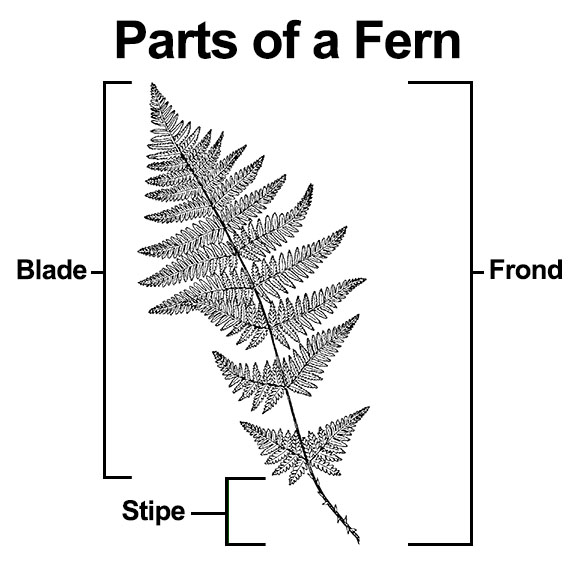 Blade: The expanded, leafy part of the frond. (the leafy portion of the frond
Blade: The expanded, leafy part of the frond. (the leafy portion of the frond Frond: The whole leaf of a fern. It includes the blade (the expanded leafy part of the frond) and the stipe (the stalk below the blade).). In contrast to the triangular shape of many ferns, the blade of the New York Fern is widest in the middle and tapers sharply at both ends. The lowest leaflets (pinnae
Frond: The whole leaf of a fern. It includes the blade (the expanded leafy part of the frond) and the stipe (the stalk below the blade).). In contrast to the triangular shape of many ferns, the blade of the New York Fern is widest in the middle and tapers sharply at both ends. The lowest leaflets (pinnae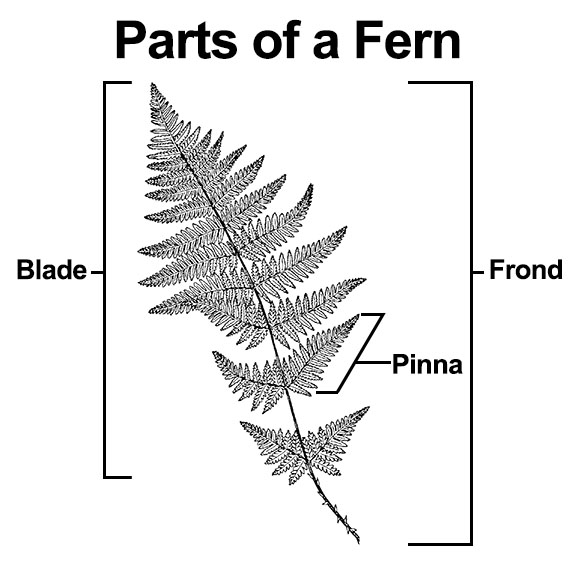 Pinna: A primary division of the blade (plural: pinnae).) are very tiny and emerge near the base of the frond, close to the rhizome
Pinna: A primary division of the blade (plural: pinnae).) are very tiny and emerge near the base of the frond, close to the rhizome Rhizome: The modified subterranean stem of a plant that sends out roots and shoots from its nodes. Rhizomes are also called creeping rootstalks and rootstocks.. This feature has given rise to a popular way of remembering this fern: "New Yorkers burn the candle at both ends" – a reference to the hectic pace of life in New York City.
Rhizome: The modified subterranean stem of a plant that sends out roots and shoots from its nodes. Rhizomes are also called creeping rootstalks and rootstocks.. This feature has given rise to a popular way of remembering this fern: "New Yorkers burn the candle at both ends" – a reference to the hectic pace of life in New York City.
The stipe Stipe: The stalk below the blade (the expanded, leafy part of the frond). (the stalk below the blade) is quite short. It is straw-colored or light green and brown and scaly at the base. The rhizome
Stipe: The stalk below the blade (the expanded, leafy part of the frond). (the stalk below the blade) is quite short. It is straw-colored or light green and brown and scaly at the base. The rhizome Rhizome: The modified subterranean stem of a plant that sends out roots and shoots from its nodes. Rhizomes are also called creeping rootstalks and rootstocks. is dark brown and slender. The soriSorus: A cluster of sporangia, usually borne on the underside or margins of the pinnae or pinnules. (plural = sori) are small, round and located near the margin.
Rhizome: The modified subterranean stem of a plant that sends out roots and shoots from its nodes. Rhizomes are also called creeping rootstalks and rootstocks. is dark brown and slender. The soriSorus: A cluster of sporangia, usually borne on the underside or margins of the pinnae or pinnules. (plural = sori) are small, round and located near the margin.
There are several other ferns also found in the Adirondack Park that might be confused with the New York Fern.
- The Hay-scented Fern (Dennstaedtia punctilobula) is found in similar habitats, also growing in large colonies. Like the New York Fern, its fronds are yellowish-green. However, the fronds of Hay-scented Ferns, as the name implies, give off a scent of crushed hay in late summer. Moreover, Hay-scented Ferns have triangular fronds which are broadest at the base, in contrast to New York Ferns, which has fronds that are widest in the middle and taper to tiny leaflets at the bottom.
- The Ostrich Fern (Matteuccia struthiopteris), which is also found in the Adirondack Park, has blades that taper gradually at the bottom. However, the Ostrich Fern is much larger than the New York Fern, growing three to five feet tall. In addition, Ostrich Fern fronds are more dramatically dimorphicFrond dimorphism: Refers to a difference in ferns between the fertile and sterile fronds., meaning that its fertile fronds are very different in appearance. The fertile fronds of the Ostrich Fern are much shorter than its sterile fronds; they grow in the center of the leaf clump with tubular-shaped structures that start out green and turn dark brown.
- The Massachusetts Fern (Thelypteris simulata) also occurs in several Adirondack Park counties, but its lower leaflets are less reduced in size than those of the New York Fern. It also is much more limited in habitat choice, being limited to acidic soils in swamps and marshy wetlands.
Uses of New York Ferns
No edible or medicinal uses for the New York Fern could be found.
Wildlife Value of New York Ferns
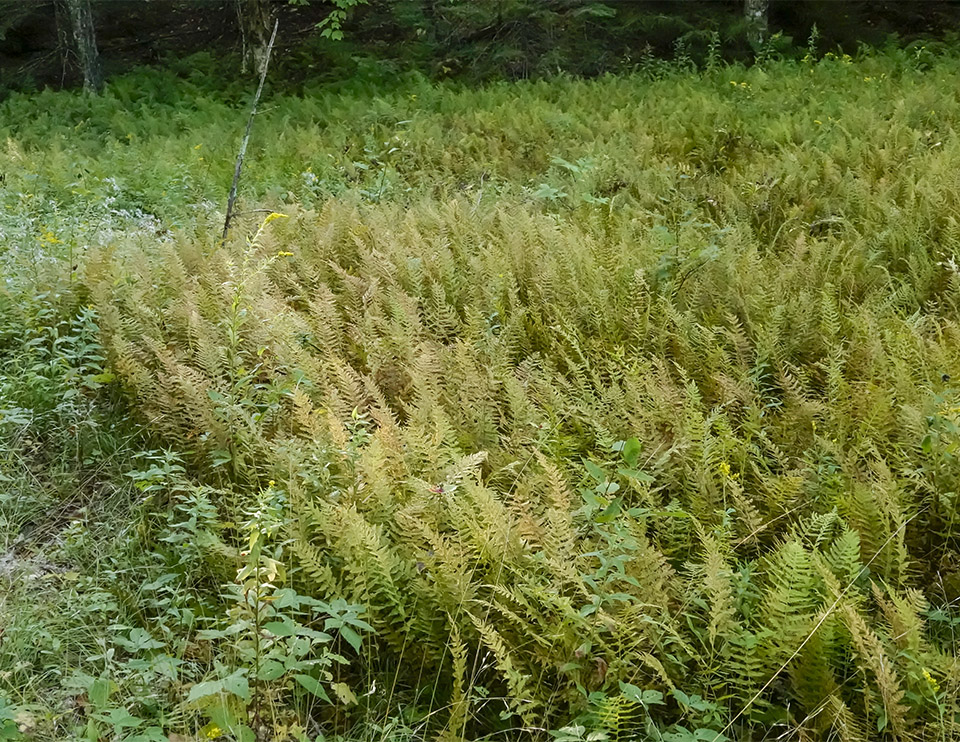
New York Ferns appear to have low value to wildlife. In general, ferns are not a major food source for mammals or birds. The small size of fern spores eliminates them from significance as a menu item. Several wildlife species (such as Wild Turkey and Spruce Grouse) reportedly consume a few evergreen ferns (such as Christmas Fern) in the winter, during times when other green plants are scarce. However, New York Ferns are deciduous, not evergreen, and so cannot provide a food source after the fronds have died back with the coming of cold weather.
Several caterpillars reportedly feed on New York Ferns. These include the Pink-shaded Fern Moth (Callopistria mollissima) and American Angle Shades (Euplexia benesimilis). The Closebanded Yellowhorn Moth (Colocasia propinquilinea) has also been observed feeding on New York Fern. An aphid (Amphorophora ampullata) reportedly sucks its plant juices.
Distribution of New York Ferns
New York Ferns are abundant throughout much of their range, with includes much of the eastern half of the United States and the southeastern provinces of Canada. The range of this fern extends from Newfoundland to Ontario, Michigan, and Illinois, south to Georgia, Alabama, Mississippi, and Tennessee. The New York Fern is listed as endangered in Illinois.
In New York State, where this fern is among the many ferns listed as exploitably vulnerable, vouchered plant specimens have been registered for nearly all counties in New York State, including all counties within the Adirondack Park Blue Line.
Habitat of New York Ferns
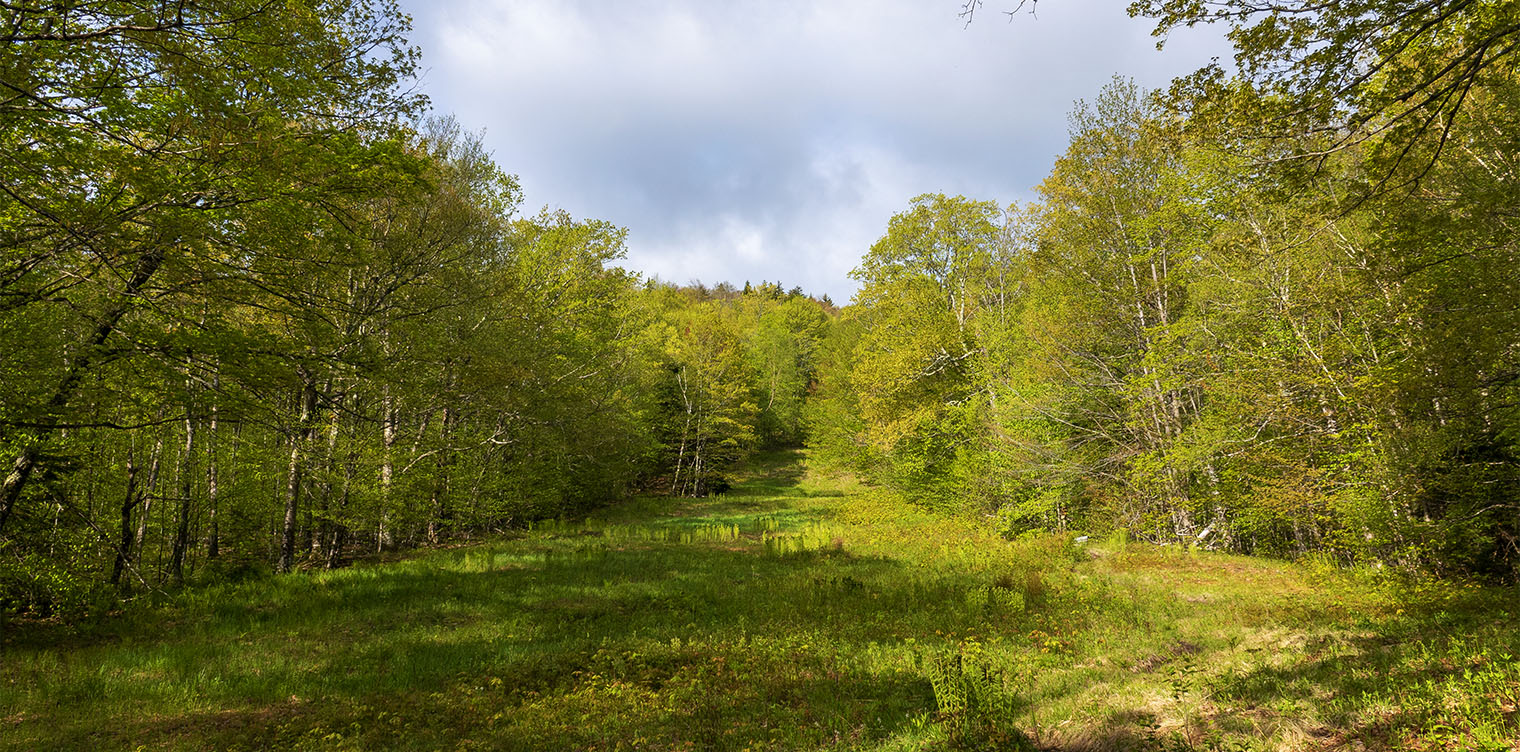
The New York Fern is classified as a Facultative plant (FAC), meaning that it occurs in both wetlands and nonwetlands. This fern is fairly flexible in terms of site requirements. It can grow in both sunny and shaded spots and in well-drained to imperfectly drained sites. It prefers slightly to moderately acid soils. Throughout its range, the New York Fern is common on sunny spots within mixed woodlands, the drier edges of swamps, and low areas along streams.
In New York State, New York Ferns are found in mesicMesic Habitat: A type of habitat with a moderate or well-balanced supply of moisture. to dry-mesic forests and forest edges. In the Adirondacks, this fern occurs in both mixed woodlands (such as hemlock-northern hardwood forest) and hardwood forests, as well as swamps and other wet places. It is often found growing in large colonies near Hay-scented Ferns.
New York Ferns are common ferns which can be seen on many of the trails covered here.
- There is a clump of New York Ferns identified with an interpretive sign in the Fern Garden adjacent to the Nature Museum at Heart Lake. You can also see New York Ferns growing on the ski slope on the Heart Lake Trail, together with Hay-scented Ferns, Royal Ferns, and Interrupted Ferns.
- This fern can be found growing in successional and mature forests on many of the trails at Heaven Hill, including the Sugar Maple Trail, Bear Cub Loop, and Big Field Loop.
- Look for New York Fern growing under deciduous trees on the Sucker Brook Trail at the Adirondack Interpretive Center.
- You can also find New York Ferns on the northern sections of the Logger's Loop Trail at the Paul Smith's College VIC where the trail leads through the Forest Ecosystem Research and Demonstration Area (FERDA), showcasing the impacts of different logging practices on natural communities.
List of Adirondack Ferns
References
Michael Kudish. Adirondack Upland Flora: An Ecological Perspective (The Chauncy Press, 1992), p.87.
Boughton Cobb. A Field Guide to Ferns and their Related Families. Northeastern and Central North America. Second Edition (Houghton Mifflin Company, 2005), pp. 210-211.
Michael Burgess. A Field Guide to the Ferns of New England and Adjacent New York. Undated, pp. 17, 120-121. Retrieved 16 February 2017.
Richard Mitchell. Atlas of New York State Ferns (New York State Museum, 1984), p. 23. Retrieved 15 February 2017.
Eugene C. Ogden. Field Guide to Northeastern Ferns (New York State Museum, 1981), p. 103, Plate 53. Retrieved 15 February 2017.
William J. Cody and Donald M. Britton. Ferns and Fern Allies of Canada (Research Branch. Agriculture Canada, 1989), pp. 243-244. Retrieved 19 February 2017.
William J. Cody. Ferns of the Ottawa District (Research Branch. Agriculture Canada, 1978), pp. 55-57. Retrieved 10 January 2018.
David B. Lellinger. A Field Manual of the Ferns & Fern Allies of the United States and Canada (Smithsonian Institution Press, 1985), p. 223, Plate 277. Retrieved 26 February 2020.
Steve W. Chadde. Northeast Ferns: A Field Guide to the Ferns and Fern Relatives of the Northeastern United States (CreateSpace Independent Publishing Platform, 2013), pp. 307-308.
Edgar T. Wherry. The Fern Guide. Northeastern and Midland United States and Adjacent Canada (Doubleday & Company, Inc., 1961), pp. 70-71, 303-304. Retrieved 23 February 2020.
William Cullina. Native Ferns, Moss & Grasses (Houghton Mifflin Company, 2008), p. 74.
Anne C. Hallowell and Barbara G. Hallowell. Fern Finder. Second Edition (Nature Study Guild Publishers, 2001), pp.8, 11, 12, 22, 28, 38, 39.
George Henry Tilton. The Fern Lover's Companion. A Guide for the Northeastern States and Canada (Little, Brown, 1923), p. 36. Retrieved 10 January 2018.
New York Flora Association. New York Flora Atlas. New York Fern. Thelypteris noveboracensis. Retrieved 29 February 2020.
New York Flora Association. New York Flora Atlas. Massachusetts Fern. Thelypteris noveboracensi. Retrieved 3 March 2020.
Integrated Taxonomic Information System. Thelypteris noveboracensisRetrieved 1 March 2020.
Integrated Taxonomic Information System. Thelypteris. Retrieved 1 March 2020.
United States Department of Agriculture. The Plants Database. New York Fern. Thelypteris noveboracensis. Retrieved 1 March 2020.
Official Compilation of Codes, Rules and Regulations of the State of New York. Title 6. Department of Environmental Conservation. Chapter II. Lands and Forests. Part 193. Trees and Plants. 193.3 Protected Native Plants. Westlaw. Retrieved 6 March 2020.
S. A. Synder,"Thelypteris noveboracensis," in United States Department of Agriculture. Fire Effects Information System (FEIS). Species Reviews. 1993. Retrieved 29 February 2020.
Flora of North America. Thelypteris. Retrieved 1 March 2020.
Flora of North America. Thelypteris noveboracensis. Retrieved 1 March 2020.
NatureServe Explorer. Online Encyclopedia of Life. New York Fern. Thelypteris noveboracensis. Retrieved 1 March 2020.
iNaturalist. Adirondack Park Observations. New York Fern. Parathelypteris noveboracensis. Retrieved 1 March 2020.
iNaturalist. New York Fern. Parathelypteris noveboracensis. Taxonomy. Retrieved 1 March 2020.
Native Plant Trust. Go Botany. New York Fern. Parathelypteris noveboracensis. Retrieved 2 March 2020.
Native Plant Trust. Go Botany. Massachusetts Fern. Parathelypteris simulata. Retrieved 2 March 2020.
New York State. Department of Environmental Conservation. New York Natural Heritage Program. Ecological Communities of New York State. Second Edition (March 2014), p. 121. Retrieved 17 October 2015.
New York Natural Heritage Program. 2020. Online Conservation Guide for Hemlock-Northern Hardwood Forest. Retrieved 29 February 2020.
New York State. Adirondack Park Agency. Preliminary List of Species Native Within the Adirondack Park Listed Alphabetically by Scientific Name and Sorted by Habit. Volume 1. Updated 10.23.2006, p. 59. Retrieved 26 January 2017.
Connecticut Botanical Society. New York Fern. Parathelypteris noveboracensis. Retrieved 3 March 2020.
Illinois Wildflowers. Grasses, Sedges, & Non-Flowering Plants. New York Fern. Thelypteris noveboracensis. Retrieved 29 February 2020.
Illinois Wildflowers. Plant-Feeding Insect Database. Thelypteris noveboracensis. Retrieved 29 February 2020.
Lady Bird Johnson Wildflower Center. Thelypteris noveboracensis. Retrieved 3 March 2020
Online Encyclopedia of Life. New York Fern. Parathelypteris noveboracensis. Retrieved 3 March 2020.
Gary Wade et al. Vascular Plant Species of the Forest Ecology Research and Demonstration Area, Paul Smiths, New York. USDA Forest Service. Research Note NE-380, pp. 4-5. Retrieved 22 January 2017.
Mark J. Twery, et al. Changes in Abundance of Vascular Plants under Varying Silvicultural Systems at the Forest Ecosystem Research and Demonstration Area, Paul Smiths, New York. USDA Forest Service. Research Note NRS-169. Retrieved 22 January 2017, pp. 8-9.
Alexander C. Martin, Herbert S. Zim, and Arnold L. Nelson. American Wildlife & Plants. A Guide to Wildlife Food Habits (Dover Publications, 1951), p. 369. Retrieved 24 February 2020.
Plants for a Future. Thelypteris noveboracensis. Retrieved 6 March 2020.
Iowa State University. BugGuide. Colocasia propinquilinea Retrieved 29 February 2020.
Timothy L. McCabe. Atlas of Adirondack Caterpillars. With a Host List, Rearing Notes and a Selected Bibliography of Works Depicting Caterpillars (New York State Museum Bulletin No. 470, 1991), pp. 81, 83. Retrieved 18 February 2017.
Charles H. Peck. Plants of North Elba. (Bulletin of the New York State Museum, Volume 6, Number 28, June 1899), p. 154. Retrieved 22 February 2017.
"What the Latin Name Means I," American Fern Journal, Volume 10, Number 0 (October-December 1920), pp. 113-115. Retrieved 10 January 2018.
"What the Latin Name Means II," American Fern Journal, Volume 11, Number 1 (January-March 1921), pp. 25-27. Retrieved 10 January 2018.
David L. Wagner. Caterpillars of Eastern North America: A Guide to Identification and Natural History (Princeton University Press, 2010), p. 428.
